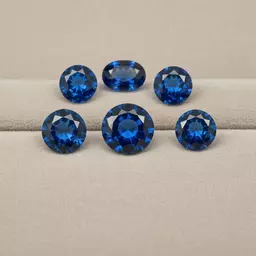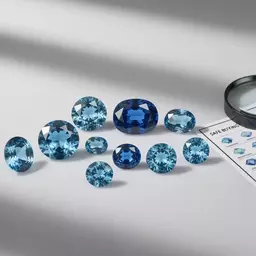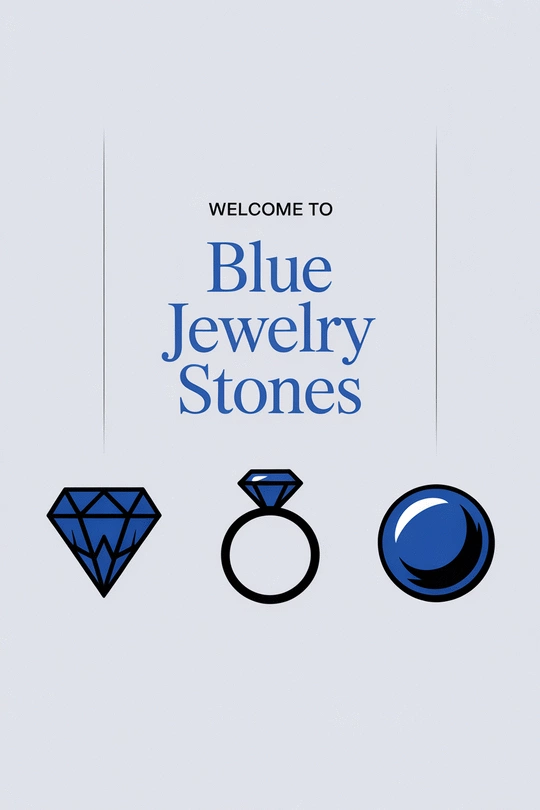Have you ever marveled at the deep, captivating hues of natural blue gemstones? These stunning crystals not only adorn our jewelry but also weave rich stories of history, symbolism, and beauty. As you explore their unique characteristics, you'll discover just how special each stone can be.
What You Will Learn
- Sapphires symbolize loyalty and nobility, known for their striking blue color and durability.
- Blue Topaz is associated with tranquility and clarity, prized for its vibrant shades.
- Aquamarine evokes feelings of peace and calm, resembling the serene ocean with its soft blue hues.
- Understanding the difference between natural and treated gemstones is crucial for making informed purchases.
- Natural gemstones are formed by natural processes, while treated stones undergo enhancements that can affect their value.
- Iolite, often called the "water sapphire," exhibits beautiful shades of blue and violet, perfect for unique jewelry pieces.
- Tanzanite, a modern marvel, showcases unique color variations depending on the angle, making it a standout choice.
- Always inquire about any treatments gemstones have undergone to appreciate their true value and beauty.
Natural vs. Treated Gemstones: Key Distinctions
Understanding the differences between natural and treated gemstones helps in making informed purchase decisions.
Understanding Natural Blue Gemstones: Types and Characteristics
Welcome to the captivating world of natural blue gemstones! As a gemologist, I have a deep appreciation for the unique beauty and significance each stone holds. In this section, we’ll explore the various types of blue gemstones and their characteristics, helping you understand what makes each one special.

Whether you’re drawn to the intense hues of sapphire or the calming shades of aquamarine, there’s a blue gemstone that resonates with everyone. Let’s dive into some popular stones that have captured the hearts of many.
Exploring Popular Blue Gemstones
When it comes to blue gemstones, a few names instantly come to mind. Here are some of the most cherished blue stones that you might consider for your collection:
- Sapphire - Known for its striking blue color and durability, sapphire symbolizes loyalty and nobility.
- Blue Topaz - With its vibrant blue shades, blue topaz is often associated with tranquility and clarity.
- Aquamarine - This gemstone’s soft blue hues evoke feelings of peace and calm, reminiscent of the ocean.
Each of these gemstones not only dazzles with its beauty but also brings its own unique story and symbolism. For instance, sapphires were historically believed to protect their wearers from envy and harm!
Key Features of Blue Sapphire, Topaz, and Aquamarine
Let’s take a closer look at the distinctive features of these popular blue gemstones:
- Sapphire: Ranges from deep royal blue to lighter shades, often featuring a rich velvety appearance, and is one of the hardest gemstones.
- Blue Topaz: Typically found in a lighter hue, it’s valued for its clarity and brilliance, making it a favorite for jewelry.
- Aquamarine: Known for its transparent quality, this stone often has a serene blue-green hue, perfect for those who love subtle elegance.
These exquisite stones each have their own charm and allure, making them perfect for rings, necklaces, or bracelets you'll cherish for years to come.
Unique Qualities of Lapis Lazuli and Turquoise
Beyond the mainstream gems, there are other blue gemstones that deserve attention. Lapis Lazuli is a deep blue stone with flecks of gold, known for its historical significance in art and spirituality. Its rich color has made it a favorite among artists and collectors alike.
Turquoise is another unique blue gemstone. Its vibrant hue and unique matrix patterns make each piece one-of-a-kind. Often associated with protection, turquoise has been used in jewelry for centuries, especially in Native American cultures.
Understanding Iolite and Tanzanite: Lesser-Known Blue Gemstones
Lastly, let’s not overlook iolite and tanzanite. Iolite is a lesser-known gem that displays beautiful shades of blue and violet, making it a favorite among those looking for something different. It's often called the "water sapphire" due to its color.
Tanzanite, on the other hand, is truly a modern marvel. Discovered in Tanzania, this stunning gemstone exhibits a unique trichroism, displaying different colors depending on the angle. Its vibrant violet-blue hue makes it a popular choice for those seeking a standout piece.
Distinguishing Natural from Treated Gemstones
With the vast variety of blue gemstones available, it’s essential to understand the differences between natural and treated stones to ensure you're making an informed purchase.
Pro Tip
When selecting a blue gemstone, consider its origin and treatment history. Natural stones not only carry more value but also unique stories that enhance their beauty. Always ask for certification to ensure you are acquiring a genuine piece that reflects its natural charm!
Distinguishing Natural from Treated Gemstones
Understanding the difference between natural and treated gemstones is crucial for anyone looking to invest in blue gemstones. As the founder of Blue Jewelry Stones, I often encounter questions about what makes a gemstone truly "natural." Let’s break this down to help you make informed choices when selecting your next piece!
Natural gemstones are those that are formed by natural processes without human intervention. On the other hand, treated gemstones have undergone processes to enhance their color or clarity. These treatments can affect the stone’s value and longevity, making it important to know what you're buying.
What Makes a Gemstone "Natural"?
A gemstone is considered natural if it has been mined and has not been altered in any significant way. Some of the most well-known natural blue gemstones include sapphire, aquamarine, and lapis lazuli. Understanding the characteristics of these stones is key to recognizing their natural beauty!

- Origin: Natural gemstones come from the earth.
- Formation: They are created through geological processes over thousands of years.
- Value: Generally, natural stones are valued higher than treated ones.
Knowing these factors can help you appreciate the uniqueness and value of your chosen gemstone. It’s important to ask the right questions when purchasing to ensure you’re getting a true natural stone.
Common Treatments and Their Impact on Value
Many gemstones undergo treatments to improve their appearance. Here are some common treatments you might come across:
- Heat Treatment: Often used on sapphires to enhance color.
- Filling: Fractures in gemstones may be filled with resin or glass to improve clarity.
- Dyeing: Sometimes used to enhance the color of stones like turquoise.
While these treatments can enhance a gemstone's aesthetic appeal, they can also lower its value. Always inquire about any treatments when considering a purchase!
Understanding Irradiation and Its Effects
Irradiation is a process where gemstones are exposed to radiation to enhance their color. A common example is blue diamonds, which can be made more vibrant through this treatment. It’s essential to know whether a gemstone has been treated in this way, as it can affect both value and marketability.
As a gemstone enthusiast, I recommend always checking for disclosure regarding any treatments. This transparency allows you to appreciate the gem more fully and make a confident purchase. For detailed information on gemstone treatments and their disclosure, resources like the American Gem Trade Association (AGTA) provide valuable insights.
Natural vs. Synthetic: Key Differences for Buyers
It's crucial to distinguish between natural and synthetic gemstones. Here’s what to keep in mind:
- Natural Gemstones: Formed in nature, unique in their inclusions.
- Synthetic Gemstones: Created in a lab, often flawless and perfect.
- Value: Natural stones typically hold more value than their synthetic counterparts.
When shopping at Blue Jewelry Stones, I encourage you to ask about the origins of each gemstone, ensuring you find the perfect piece that resonates with you. To further verify the authenticity and characteristics of your gemstones, consider obtaining a gemological report from reputable labs like GIA. Understanding gemstone certificates is also vital, and organizations like the International Gem Society offer excellent guides on what to look for in these documents.
Frequently Asked Questions About Blue Gemstones
Here are some common questions about natural blue gemstones:
- What are the most popular natural blue gemstones?
The most popular natural blue gemstones include Sapphire, Blue Topaz, and Aquamarine, each cherished for their unique beauty and characteristics. - How can I tell the difference between a natural and a treated gemstone?
Natural gemstones are formed without human intervention, while treated gemstones undergo processes to enhance their appearance. It's crucial to ask sellers for disclosure on any treatments and to look for gemological certifications for verification. - What are some lesser-known but equally beautiful blue gemstones?
Iolite, often called "water sapphire," and Tanzanite, known for its unique trichroism, are beautiful lesser-known blue gemstones that offer distinct charm. - Do treatments affect the value of a gemstone?
Yes, treatments can significantly impact a gemstone's value and longevity. While some treatments are common and accepted, they can generally lower the market value compared to untreated natural stones. - Why is it important to get a gemstone certified?
Certification from reputable gemological laboratories provides an unbiased assessment of a gemstone's authenticity, characteristics, and any treatments it may have undergone, ensuring you make an informed purchase and appreciate its true value.
Recap of Key Points
Here is a quick recap of the important points discussed in the article:
- Sapphire: Known for its durability and striking blue color, symbolizes loyalty and nobility.
- Blue Topaz: Represents tranquility and clarity, with vibrant blue shades.
- Aquamarine: Evokes peace and calm, often with soft blue hues reminiscent of the ocean.
- Lapis Lazuli: A deep blue stone significant in art and spirituality, known for its gold flecks.
- Turquoise: Unique for its vibrant hue and matrix patterns, often associated with protection.
- Iolite: Displays shades of blue and violet, known as the "water sapphire."
- Tanzanite: A modern marvel with unique trichroism, showing different colors from different angles.
- Natural vs. Treated Gemstones: Understanding the differences is crucial for informed purchases, as treatments can affect value.







